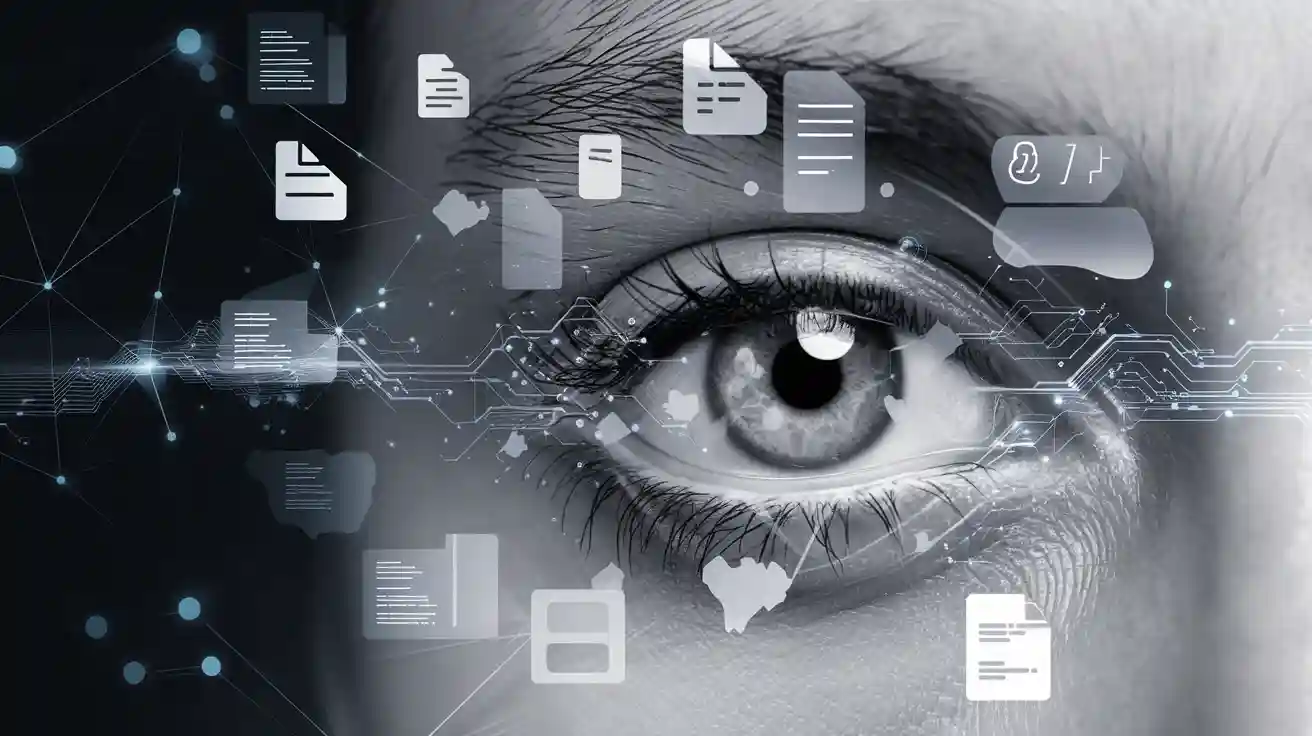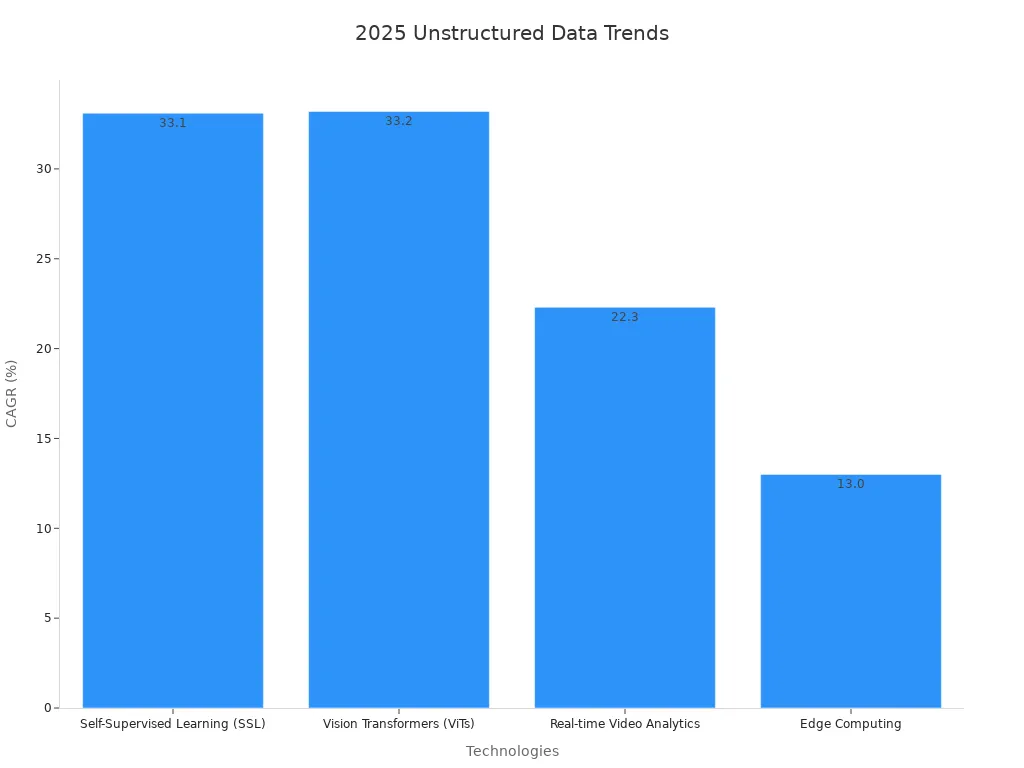
Unstructured data shapes the way machines see and understand the world in 2025. Companies now collect more unstructured data than ever before. Images, videos, and sensor data challenge every Unstructured Data machine vision system. Many teams must solve problems that structured data cannot address. New AI models find patterns in unstructured data and open doors to better results. Leaders should ask how unstructured data will change their business or technical plans.
Key Takeaways
- Unstructured data includes images, videos, audio, text, and sensor data that do not fit into traditional tables, requiring advanced AI to analyze.
- Machine vision systems face challenges like messy data, large volumes, and the need for powerful computing to process unstructured data accurately and quickly.
- AI technologies such as deep learning and natural language processing help machines find patterns and extract useful information from complex unstructured data.
- New trends like self-supervised learning, vision transformers, and edge computing are driving rapid growth and better use of unstructured data in machine vision.
- Strong data management and cloud integration improve efficiency, accuracy, and security, helping businesses gain a competitive edge by using unstructured data effectively.
Unstructured Data Defined

What Is Unstructured Data?
Unstructured data refers to information that does not follow a fixed format or schema. Unlike structured data, which fits neatly into tables or databases, unstructured data comes in many shapes and sizes. This type of data can be human-generated, such as photos or videos, or machine-generated, like sensor readings. It often includes text documents, emails, images, audio files, and video files. Because unstructured data lacks a predefined structure, traditional analysis methods struggle to process it. Machine vision systems rely on advanced techniques, such as deep learning and computer vision, to extract meaning from these complex data sources.
Note: Unstructured data is flexible and large in volume. It often holds valuable insights that structured data cannot provide.
Types in Machine Vision
Machine vision systems work with several types of unstructured data. Each type presents unique challenges and opportunities for analysis.
- Images: Formats like JPEG, PNG, and TIFF are common. Medical imaging, such as X-rays and MRIs, uses deep learning to detect patterns and abnormalities.
- Videos: Files such as MP4, AVI, and MOV allow real-time analysis. Security systems use video streams to identify people and monitor activities.
- Audio: Recordings from customer service calls or speech-to-text applications help categorize conversations and improve services.
- Text: Social media posts, emails, and documents provide rich information. Natural language processing helps analyze sentiment and extract key details.
- Sensor Data: IoT devices generate massive amounts of unstructured data. By 2025, these devices are expected to produce over 73 zettabytes of data, fueling machine vision advancements.
Machine vision systems must handle this diversity. They use specialized hardware and algorithms to process unstructured data efficiently. The rapid growth in data volume and AI investment highlights the importance of mastering unstructured data for future success.
Unstructured Data Machine Vision System
System Challenges
Unstructured data machine vision systems face many obstacles in 2025. These systems must process information that lacks a clear format or structure. The data comes from many sources, such as images, videos, audio, and text. Each type brings its own set of problems.
- Unstructured data often lacks organization, making it hard to classify and retrieve.
- Data extraction and transformation become difficult due to inconsistent layouts and varying data quality.
- Optical character recognition (OCR) struggles with poor image resolution and diverse document formats.
- Machine learning models need large datasets, which increases the complexity of data management and requires more computing power.
- Multimodal data, such as combining images and audio, adds extra layers of challenge. Feature extraction, representation learning, and integration with text all demand advanced solutions.
- The sheer volume of unstructured data from different sources makes sorting and identifying relevant information a slow process.
- Data integrity and quality issues can lead to errors and inconsistencies.
- Analysis of unstructured data is time-consuming and needs specialized skills and tools.
- Lack of labeled data makes supervised machine learning difficult.
- The rise of AI-generated low-quality content can contaminate training datasets, so robust filtering is necessary.
Note: Data quality issues, scalability, and privacy concerns are critical. Unstructured data is messy and often contains errors or biases. Systems must use rigorous data cleansing and normalization. As data volumes grow, scalable infrastructure and distributed computing become essential. Privacy regulations, such as GDPR, require anonymization and compliance.
A technical report highlights some key performance metrics for unstructured data machine vision systems:
| Metric | Measurement / Description |
|---|---|
| Inspection Speed | One part inspected every two seconds at Coors Ceramics Company |
| Error Rates | AI-driven systems reduce error rates to below 1%, manual inspections have ~10% error rate |
| Latency | Time delay in processing data, critical for real-time systems |
| Throughput | Amount of data processed in a given time, indicating efficiency |
| Error Rates | Frequency of errors in predictions, essential for reliability |
These metrics show that unstructured data machine vision systems must balance speed, accuracy, and reliability.
AI and ML Solutions
Machine learning and artificial intelligence play a central role in solving the challenges of unstructured data machine vision systems. These technologies help extract structure and meaning from complex data.
- Deep learning models, such as convolutional neural networks (CNNs), process images and videos to detect patterns, objects, and anomalies.
- Natural language processing (NLP) techniques analyze text and audio, extracting key details and sentiment from unstructured sources.
- Generative AI models create synthetic data to augment training sets, improving model robustness and performance.
- Automated data extraction tools convert unstructured data into structured formats, making it easier for downstream analysis in the machine learning pipeline.
- Feature extraction and representation learning enable systems to handle multimodal data, integrating information from images, text, and audio.
- Advanced filtering and validation mechanisms detect and remove low-quality or AI-generated content, protecting the integrity of training datasets.
Recent data shows that AI, machine learning, and NLP solutions deliver real benefits across industries:
| Industry | AI/ML/NLP Application in Unstructured Data Extraction | Impact / Benefits |
|---|---|---|
| Healthcare | Radiology imaging anomaly detection, NLP on clinical notes, patient sentiment analysis | Faster diagnoses, reduced clinician burnout, improved outcomes |
| Manufacturing | Defect detection, NLP on maintenance logs, CCTV analysis | Reduced downtime, higher quality, safer environments |
| Telecom | Churn prediction, NLP on technician logs, AI bots | Improved retention, faster resolution, higher efficiency |
| Finance | Fraud detection, NLP for contract analysis, call center transcription | Enhanced compliance, reduced risk, better service |
| Retail & eCommerce | NLP for review mining, visual search, sentiment tracking | Smarter design, optimized inventory, personalized journeys |
| Legal & Compliance | Contract review automation, eDiscovery, regulatory mapping | Reduced review time, improved compliance, lower costs |
| Government & Public Sector | Public safety monitoring, sentiment analysis, document digitization | Better governance, safer cities, more responsive services |
Machine learning pipelines now include automated data preprocessing, feature engineering, and model validation. These steps ensure that unstructured data becomes usable for computer vision and NLP tasks. AI-driven systems process large volumes of data quickly and with high accuracy. They help organizations make faster decisions and gain actionable insights.
Tip: Investing in robust machine learning pipelines and advanced data extraction tools is essential for any unstructured data machine vision system. These investments improve efficiency, accuracy, and scalability.
Why It Matters in 2025
Trends and Growth
The machine vision industry is changing fast in 2025. New technologies help companies use unstructured data in ways that were not possible before. Self-supervised learning, vision transformers, and real-time video analytics are leading this change. These tools help systems learn from data without needing many labels. Edge computing and federated learning also make it easier to process visual data quickly and safely.
| Trend / Technology | Market Projection / Growth | CAGR / Timeframe | Significance to Unstructured Data in Machine Vision |
|---|---|---|---|
| Self-Supervised Learning (SSL) | Market growth from $7.5B (2021) to $126.8B (2031) | 33.1% CAGR (2022-2031) | Reduces need for labeled data, enabling use of unstructured data in healthcare, autonomous systems |
| Vision Transformers (ViTs) | Market growth from $280.75M (2024) to $2.78B (2032) | 33.2% CAGR | Holistic image processing, driving adoption in object detection and segmentation |
| Real-time Video Analytics | Market growth from $8.3B (2023) to $22.6B (2028) | 22.3% CAGR | Demand for actionable insights from unstructured video data in security, transportation, entertainment |
| Edge Computing | Market growth from $60.0B (2024) to $110.6B (2029) | 13.0% CAGR | Enables faster, local processing of visual data, reducing latency and bandwidth use |
| Federated Learning | Qualitative growth and adoption in privacy-sensitive sectors | N/A | Enables decentralized model training on unstructured data without exposing raw data |

Synthetic data generation is also rising. Companies use it to fill gaps when real-world data is limited. Synthetic data helps train AI models, but it cannot fully replace the value of real unstructured data. This trend shows how important it is to manage and use unstructured data well.
Industry reports show steady growth in the machine vision market. The market is expected to reach $7.7 billion by 2029. Deep learning and neural networks drive much of this growth. Software sales and 3D camera revenues are also rising fast.
Business Impact
Unstructured data changes how businesses make decisions. Companies now use images, videos, and sensor data to get real-time insights. This helps them react faster to market changes. For example, financial firms use satellite images and social media to improve forecasts. These new sources give more detail than traditional data.
Machine learning lets companies find patterns in large, messy datasets. This leads to better predictions and smarter automation. Businesses in healthcare, retail, and manufacturing see higher productivity and lower costs. Advances in computing power, like GPUs and cloud services, make it easier to process unstructured data at scale.
Note: Companies that invest in unstructured data and machine learning gain a strong edge. They can spot trends early, improve products, and serve customers better. In 2025, the ability to use unstructured data will set leaders apart from the rest.
Strategies for Success
Data Management
Effective data management forms the backbone of any successful machine vision system. Teams must first discover unstructured data across all environments. They gain visibility by collecting metadata and understanding where data lives. Next, they catalog this data, tagging it for easy search and access. Automated classification with machine learning, such as natural language processing, helps sort data by sensitivity and content. Assigning user roles and permissions prevents unauthorized access and data leaks. Tracking data lineage ensures transparency and compliance. Automated labeling and curation keep data quality high. Finally, teams extract useful information using tools like optical character recognition and high-fidelity parsing.
Tip: Organizations that follow these steps see measurable efficiency gains. For example, Walmart improved inventory turnover by 25%, and General Electric reduced inspection time by 75% through strategic management of unstructured data.
Cloud Integration
Cloud integration boosts the processing power of machine vision systems. Enterprises combine structured and unstructured data in the cloud, setting the stage for advanced analytics. Platforms like AWS, Azure, and Snowflake handle complex data types, including images and videos. Integration tools connect different data sources in real time or batch mode. Cloud infrastructure supports evolving AI technologies, making analysis faster and more accurate.
Key performance metrics for cloud-based systems include:
- Disk usage: Monitors storage and prevents service interruptions.
- Bandwidth: Measures data transfer rates for smooth operations.
- Latency: Tracks network delays, affecting user experience.
- Requests per minute: Shows system traffic for scaling.
- Error rate: Indicates reliability and system health.
- Mean time to repair: Reflects how quickly teams fix issues.
These metrics help organizations plan capacity, maintain stability, and improve decision-making.
Best Practices
Industry leaders follow proven best practices to maximize the value of unstructured data in machine vision. They start by gaining full visibility and building a comprehensive data catalog. Automated classification and strict access controls protect sensitive information. Tracking data lineage and curating data ensure quality and compliance.
| Case Study / Source | Industry Sector | Quantitative Evidence | Key Outcome |
|---|---|---|---|
| Crowe and Delwiche | Food & Agriculture | Improved sorting accuracy | Consistency over manual inspection |
| Zhang and Deng | Fruit Bruise Detection | Relative errors within 10% | High defect detection precision |
| Kanali et al. | Produce Inspection | Labor savings | Increased objectivity |
| ASME Systems Sales | Commercial Adoption | $65 million sales | Strong market trust |
These results show that best practices lead to higher accuracy, reduced labor, and greater commercial success. Teams that invest in robust data management and cloud integration set themselves up for long-term growth.
Machine vision in 2025 relies on advanced AI, strong data management, and cloud integration. Teams that prepare now will lead the industry. They should invest in new tools, train staff, and review data strategies. Leaders must watch trends and update systems often. Success depends on learning and adapting as technology changes.
Tip: Stay informed about new solutions and encourage teams to experiment with new approaches.
FAQ
What makes unstructured data different from structured data?
Unstructured data does not fit into tables or databases. It includes images, videos, and text. Machine vision systems need special tools to process this data. Structured data uses rows and columns, making it easier to analyze.
How do companies use unstructured data in machine vision?
Companies use unstructured data to improve quality control, automate inspections, and monitor safety. They analyze images and videos to find defects, track products, and detect unusual events. This helps them make better decisions and save time.
Why is data quality important for machine vision systems?
High-quality data leads to accurate results. Poor data can cause errors and missed detections. Teams must clean and label data before using it. Good data management ensures reliable machine vision performance.
What role does AI play in handling unstructured data?
AI helps systems find patterns in unstructured data. Deep learning models process images and videos. Natural language processing works with text and audio. AI makes it possible to extract useful information from complex sources.
How can businesses prepare for the growth of unstructured data?
Businesses should invest in strong data management, cloud integration, and staff training. They need to update their systems often. Staying informed about new AI tools helps them stay ahead in the market.
See Also
How Synthetic Data Is Transforming Machine Vision Capabilities
Understanding Edge AI Applications In Real-Time Vision By 2025
A Deep Dive Into Synthetic Data For Vision Systems
The Role Of Deep Learning In Improving Vision Systems
Essential Insights Into Computer And Machine Vision Technologies









